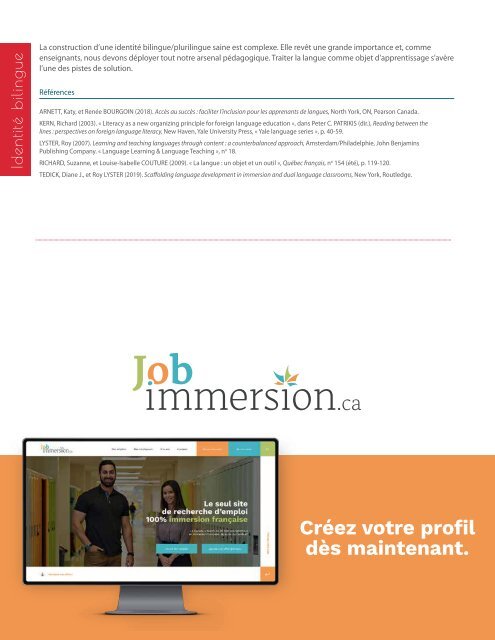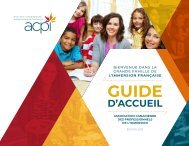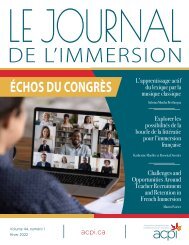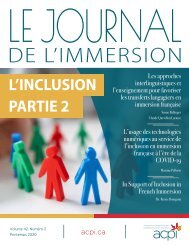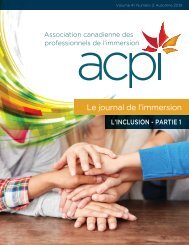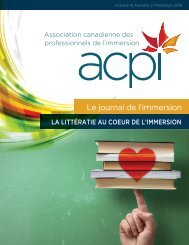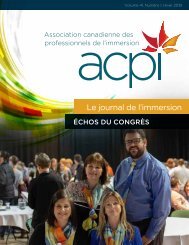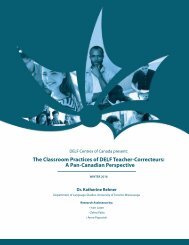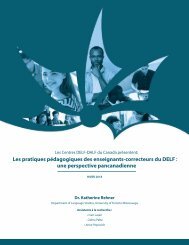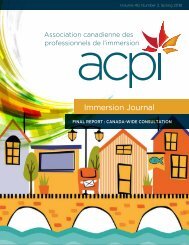Vol_43_n2_web_f
Create successful ePaper yourself
Turn your PDF publications into a flip-book with our unique Google optimized e-Paper software.
Identité bilingue<br />
Identité bilingue<br />
La construction d’une identité bilingue/plurilingue saine est complexe. Elle revêt une grande importance et, comme<br />
enseignants, nous devons déployer tout notre arsenal pédagogique. Traiter la langue comme objet d’apprentissage s’avère<br />
l’une des pistes de solution.<br />
Références<br />
ARNETT, Katy, et Renée BOURGOIN (2018). Accès au succès : faciliter l’inclusion pour les apprenants de langues, North York, ON, Pearson Canada.<br />
KERN, Richard (2003). « Literacy as a new organizing principle for foreign language education », dans Peter C. PATRIKIS (dir.), Reading between the<br />
lines : perspectives on foreign language literacy, New Haven, Yale University Press, « Yale language series », p. 40-59.<br />
LYSTER, Roy (2007). Learning and teaching languages through content : a counterbalanced approach, Amsterdam/Philadelphie, John Benjamins<br />
Publishing Company. « Language Learning & Language Teaching », n o 18.<br />
RICHARD, Suzanne, et Louise-Isabelle COUTURE (2009). « La langue : un objet et un outil », Québec français, n o 154 (été), p. 119-120.<br />
TEDICK, Diane J., et Roy LYSTER (2019). Scaffolding language development in immersion and dual language classrooms, New York, Routledge.<br />
Créez votre profil<br />
dès maintenant.<br />
Making the inclusivity shift<br />
Brandon Curr | Director of Instruction | Burnaby Schools, BC | brandon.curr@burnabyschools.ca<br />
Anne-Marie Bilton | Facilitatrice pédagogique de français langue seconde à Burnaby en Colombie-Britannique |<br />
ambinbc@gmail.com<br />
Brandon Curr<br />
Anne-Marie Bilton<br />
The evolving inquiry<br />
on inclusion in the<br />
context of French<br />
immersion<br />
In education, questions<br />
of equity, access,<br />
and inclusion have<br />
generated significant<br />
inquiry. Similarly,<br />
questions of access,<br />
equity, and inclusion<br />
in French immersion<br />
have abounded across<br />
every province in<br />
Canada. Originally,<br />
much of the discussion<br />
in the context of French<br />
immersion centered<br />
on the “suitability” of<br />
various learners, and<br />
what inclusion meant.<br />
The following citation<br />
by Canadian researchers<br />
is an excellent summary:<br />
“ Inclusivity in FSL programs, at minimum, refers to the<br />
access provided to children who have traditionally been<br />
marginalized from the program. However, inclusivity is also<br />
about reform and practices in the classroom. The issue of<br />
inclusivity in FSL programs (e.g., Allen, 2007; Mady, 2007;<br />
Mady & Arnett, 2009) was previously discussed as a matter<br />
of suitability of learners for the program (e.g., Cummins,<br />
1987; Genesee, 2006). In a recent article, Mady and Arnett<br />
(2016) examined how inclusivity has been a challenge to<br />
FSL programs in Canada. As they pointed out, there is not<br />
only some debate about who should be able to access<br />
these programs, but also how to practice and implement<br />
inclusivity. Despite this limitation, some FSL research has<br />
taken on a social justice slant in language education, moving<br />
from discussions of suitability to inclusivity (e.g., Arnett et al.,<br />
2014; Byrd Clark, Mady, & Vanthuyne, 2014; Heffernan, 2011;<br />
Mady & Black, 2012).” (Mady & Masson, 2018)<br />
This shift in conception is part of a trend in the evolution<br />
of inclusion and is explained in Shelley Moore’s informative<br />
video which asks us to assess where we are in our journey,<br />
and to query if we can do better, and if so, how? (Moore,<br />
2018) The question of “how” has assumed new import in<br />
relation to French immersion. Although we have made<br />
immense progress in including diverse learners in our<br />
French immersion programs across Canada, we have<br />
persisting concerns at all levels in the system, about how to<br />
best serve them.<br />
Unique programs, unique challenges<br />
The amount of language exposure correlates<br />
directly with proficiency in the acquisition of an<br />
additional language and is a significant success<br />
factor, especially when students are learning the<br />
language in a minority setting where their exposure<br />
to the language is exclusively in the confines of the<br />
classroom.<br />
With students having been absent from school for<br />
prolonged periods because of the pandemic, school and<br />
district personnel are thinking about how to serve learners<br />
as they return to the classrooms. In our work connecting<br />
with districts, in dialogues across post-secondary<br />
institutions, and in provincial or national workshops these<br />
issues of how to best serve all learners surface regularly.<br />
As immersion students reintegrate into the post-pandemic<br />
schooling, leaders have an opportunity to consider fresh<br />
questions to evolve a more complex understanding that<br />
(as cited in Ontario Ministry of Education, 2009) “inclusion<br />
is not bringing people into what already exists; it is making<br />
a new space, a better space for everyone’’ (Mady & Masson,<br />
2018). As leaders in the French immersion programs seek<br />
to make a better space, we will want to adopt an inquiry<br />
mindset as proposed by Kaser and Halbert (2017):<br />
36 | LE JOURNAL DE L'IMMERSION<br />
<strong>Vol</strong>. <strong>43</strong>, n o 2, été 2021 | 37


